Vintage apple tree Streyfling
Apple-tree Streifling is an old variety that came to Russia from the Baltic states. It appeared as a result of folk selection more than 250 years ago. It spread to the Nordic countries (Scandinavia, Germany, Holland). Now it is grown in private plots.
- Characteristics of the variety
- Wood
- Fruit
- Taste characteristic
- Keeping quality
- Yield
- Pollinating varieties
- Apple vaccination compatibility
- Winter hardiness
- Disease and pest resistance
- Transportation
- In which regions are they growing
- Application area
- Landing
- Landing dates
- Landing technology
- Care
- Watering
- Pruning and shaping the crown
- Top dressing
- Protection against diseases and pests
- Preparing for winter
- Features of ripening and fruiting
- Harvesting and storage
- Subspecies
- Yellow
- Red
- Early
- Rootstock options
- On the dwarf
- Columnar
- Gardeners reviews
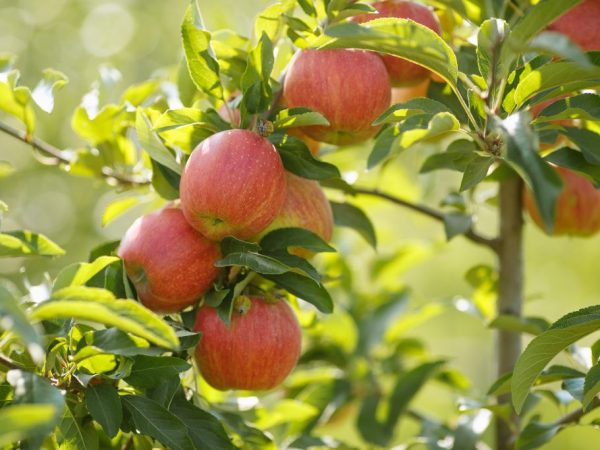
Vintage apple tree Streyfling
Characteristics of the variety
For many decades, the Streyfling apple tree has been cultivated in villages and has received several popular names, the most popular of which is Autumn striped.
Other nicknames:
- Autumn striped whale.
- Lead.
- Liflyandskoe.
- Grafenstein.
- Trim or Trim.
- Striped.
- Starostino.
- Amtamanskoe.
Wood
The tree is tall and large, with a wide and dense crown shaped like a cauldron.
Its description:
- Height - 7-8 m.
- The crown circumference is 9-10 m.
- Trunk with dark smooth bark.
- Shoots with a pronounced edge, brown or chestnut color.
- The branches are at a 90 ° angle to the trunk, often drooping.
- The buds are gray, the seedlings are yellowish and elongated.
- The foliage is dense, almost completely covering the branches.
- The leaf is wrinkled, folds in half in the area of the central vein, the edge has deep teeth, the plate is well pubescent.
- The petiole is thin, reddish, growing almost at right angles to the branch.
The flowers of the apple tree are large, white, and the young buds are pink. The flower resembles a saucer or cup with curved edges.
Fruit
According to the description, Streifling apples weigh 80-110 g (in some cases, their weight reaches 200 g). Ribs are clearly visible near the stalk.
The color of an unripe apple is green, then it turns yellow and is half covered with orange-red stripes, which turn brown when stored for a long time. There is a completely red variety.
The pulp is creamy or yellow in color, under the skin it may be slightly reddish.
Calorie content - 50-70 kcal. The fruit contains about 10.1% sugar, 0.57% acids, 12% pectin substances. 100 g contains 8.3 mg of ascorbic acid.
Taste characteristic
The pulp is coarse and friable, while very juicy. Strong wine and raspberry notes are felt.
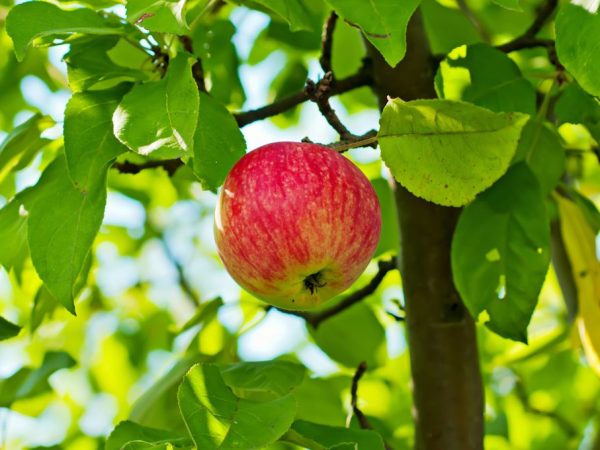
The fruit smells good
The taste largely depends on the growing region. In northern latitudes, it is sweet and sour, in southern latitudes, sweet and sour.
The aroma is bright, spicy. Apple tasting score - 4.5 points out of 5.
Keeping quality
Autumn striped apples do not have the best keeping quality.
They can be kept in the refrigerator or basement until mid-December. Already with the beginning of winter, the pulp becomes loose, like cotton wool, and the taste is insipid.
The percentage of juice in fruits also drops sharply.Therefore, it is recommended to eat apples fresh, in the first 1-1.5 months after harvest.
They make delicious juices, jams or marmalades.
Yield
Record harvests can be harvested from one tree - up to 350-420 kg.
But you can get such a number of fruits only from mature apple trees, 25-30 years old. They are able to give stable yields for another 10 years after their maximum peak, then failures occur, the variety begins to bear fruit well only once every 2-3 years.
To increase the yield, the tree is rejuvenated, fed with organic fertilizers, and watered abundantly in dry summer.
Pollinating varieties
For the formation of ovaries, the apple tree must be pollinated from other trees. This is due to the evolutionary fitness that ensured the genetic diversity of the species.
The Streyfling apple variety is almost incapable of self-pollination. If it grows alone in the garden, very few ovaries form after flowering. To do this, pollinators should be planted nearby. Best suited:
- Folding
- Antonovka
- Welsey
- Rossosh striped
- Zelenka Dniprovska
- Slav
The pollinator must be located at least 50 m from the Streifling.
Apple vaccination compatibility
The variety can be inoculated with almost all cultivated varieties. The best results are obtained by grafting on the tree of the same variety of cuttings grown from seeds.
Also, the Shtrifel can be grafted onto any dwarf variety. This will speed up the onset of fruiting, but reduce the lifespan of the apple tree.
Winter hardiness
Frost resistance is one of the advantages. Shoots are able to withstand even the most severe frosts, typical for Siberia or the Urals. In the suburbs, they never suffer from the cold.
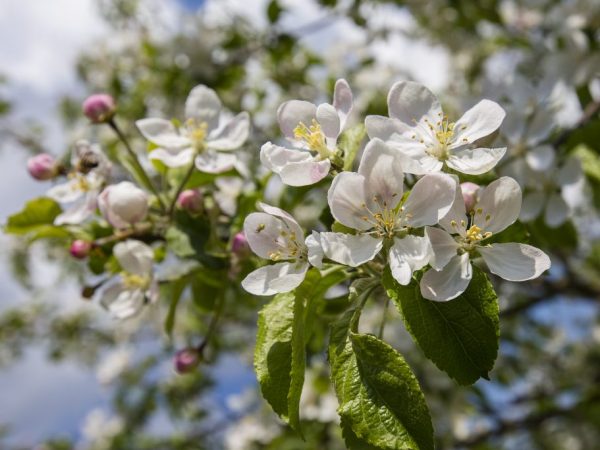
The tree tolerates frost well
Even if young branches freeze, they regenerate well. For example, there are still apple trees in the gardens that survived at a young age one of the coldest winters of the twentieth century, in 1955-56. They bear fruit to this day and give excellent yields.
Disease and pest resistance
Resistance to diseases and pests is average. In many ways, it depends on the place of cultivation and weather conditions. It is struck by scab, fruit rot. Often it is attacked by a stalk, a sawer, aphid. Fungal pathologies often threaten apple trees in damp and cold summers.
Transportation
The flesh of the fruit is loose and the skin is thin, but they tolerate transportation well. The crop can be transported over long distances. It will be possible to preserve the quality of products during transportation if you take into account several rules:
- it is better to transport apples in the first weeks after harvest;
- for transportation use wooden or plastic boxes specially designed for fruit
- it is best to put the fruits in separate cells or overlap them with a layer of shavings, sawdust, dry cane, synthetic packaging material;
- use freight transport with cooling systems.
In which regions are they growing
The Shtrifel variety grows well throughout the European part of the country: the apple tree adapts perfectly in the Leningrad and Moscow regions. It adapts well and gives good yields in the sharply continental Siberian climate.
You can find in the State Register of such regions:
- Northern District
- Northwestern District
- central part
- Volgo-Vyatsky district
- Central Black Earth
- Middle Volga basin
In arid regions, the tree grows worse, it needs to be constantly watered. They also love fertile soil, do not take root well on clay and loamy soils.
Application area
On an industrial scale, the Shtrifel variety is rarely grown: apples appear late, and they are stored only for 2-3 months, while the tree itself takes up a lot of space on the site.
There is a prospect of breeding selling varieties on a dwarf rootstock.
Most often, the fruits are eaten fresh in the autumn months. They can also squeeze a lot of juice. Loose pulp is well boiled in the manufacture of jam.Jam with slices turns out a little worse, they quickly disintegrate into lumps in syrup.
Small quantities of crops can be sold at the market or grocery stores.
Landing
The first step in growing an apple tree is choosing the right seedlings. They can be bought in nurseries of any region, even those brought from the south take root well in the north.
Their bark is usually brown or chestnut, several shades lighter than that of mature trees. Lentils are yellowish, elongated.
Leaves with a felt edging, a jagged edge and a spiral top, they densely cover the stem.
Landing dates

In the northern regions, planting is better in spring.
The timing is chosen depending on the climate, age, planting tasks:
- In autumn, it is better to plant in the south. Such terms are also suitable for mature trees or seedlings over 2 years old. The optimal time is early or mid-October.
- Spring planting is ideal for northern latitudes. In this case, you need to use seedlings up to two years of age. Dates - late April or early May.
Landing technology
It is best to plant the tree in an area protected from the wind and well-lit by the sun.
With an autumn planting, a hole is dug in 2-3 weeks, with a spring planting - from autumn. In depth, it should be 80-100 cm, in diameter - 100-120 cm.The distance between the two pits is 4.5-5.5 m.
The following mixture is placed on the bottom:
- Ash - 1 tbsp.
- Potassium sulfate - 4 tablespoons
- Superphosphate - 1 tbsp.
- Compost, humus or rotten manure - 3 buckets
Sprinkle everything on top with a thin layer of earth. If the soil is clayey, it is mixed with sand. It is better to add peat to sandy soil. With a high standing of groundwater, drainage from expanded clay or pebbles is placed on the bottom.
Before planting, the pit should be half full of soil with fertilizer. The seedling is placed strictly in the center, the roots are carefully straightened. Sprinkle the tree with soil so that its root collar rises above the surface by 7-8 cm. The soil is compacted, 3-4 buckets of water are poured under the apple tree, mulch is put on top.
If the apple tree is planted in spring, in the first 2 months it is watered 1-2 times a week, then 2-3 times a month. For autumn planting, you need to water 3 more times over 2 weeks, this will prevent the roots from freezing.
Care
Normal apple tree care Streifling is a guarantee of high yields and tree health. It provides for standard measures - watering, feeding, pruning, disease prevention.
Watering
The variety loves moisture and does not tolerate dry soil. It needs to be watered regularly all summer, especially when there is a long absence of rainfall. Watering is carried out 2-3 times a month.
For young apple trees, you need 50 liters of water at a time (4-5 buckets), for old ones - 80-100 liters (7-10 buckets).
Water in the early morning or before sunset. To retain moisture, mulch is made from high moor peat, straw, sawdust or small pebbles.
Pruning and shaping the crown
The crown has been formed over several years. In the first 3-4 years, they pay attention to the south side, then move on to the north. After removing the branches, the places of the cuts are carefully sealed with garden pitch.
An image of young trees
Immediately after planting, it is advised to remove only broken and damaged branches, with growth directed downward, parallel to the trunk or into the crown. When the tree is 7-8 years old, crown formation and stimulating pruning are carried out.
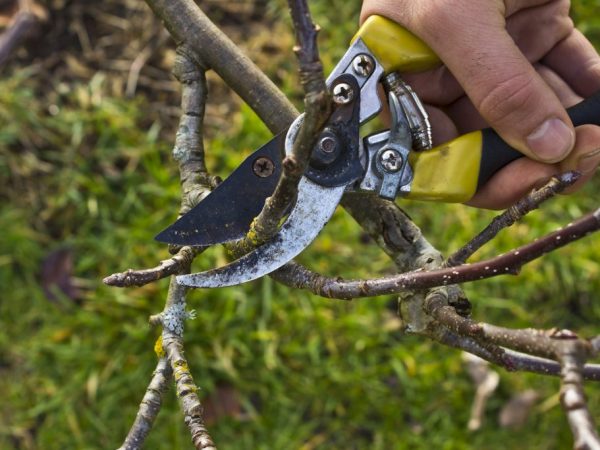
Pruning stimulates tree growth
In the spring, when the juices have not yet begun to circulate, annual shoots are cut off so that 4-5 buds remain on them. This increases the number of ovaries and also removes dry and frozen branches.
Pruning old trees
carry out formative and rejuvenating pruning. They start it in the fall, when all the foliage has fallen. Broken and dry branches are removed at this time.
In the spring, they begin to cut the upper branches, they should always be shorter than the middle and lower ones. Shoots growing too close to the trunk are also removed. Frostbite branches are removed completely and skeletal branches are cut in half to stimulate lateral growth.
Top dressing
Fertilization, like watering, significantly increases yields. Top dressing is applied three times per season: before the beginning of flowering, during the formation of the ovary and after the ripening of the fruits.
First feeding:
- Urea - 200 g
- Water - 10 l
Second feeding:
- Copper sulfate - 1 g
- Boric acid - 0.5 g
- Water - 10 l
During the formation of the ovaries, you can also add organic matter - a solution of manure 1:10 or droppings 1:15. To enrich the soil under the apple tree with nitrogen, you can also use siderite plants (lupine, vetch, clover, rye, mustard). They are planted under a tree, and a month later, when the green mass increases, they are added dropwise near the roots.
Third feeding:
- Superphosphate - 20g
- Potassium chloride - 35 g
This amount of fertilizer is applied per 1 m² of soil. At the end of October, compost mulch is made around the trunk. It will protect the roots from frost, and in the spring will replenish the soil with mineral and organic substances.
Protection against diseases and pests
The Streifling variety can be neighing by sawflies, moths, aphids, spider mites: these pests feed on the fruits and leaves of the apple tree, reduce the yield and spoil the presentation of the fruit.
The most common diseases are scab, powdery mildew, fruit rot, which are caused by a fungus.
To protect against fungal diseases and insect pests, preventive treatment is carried out in the spring. A solution of copper sulfate or Bordeaux liquid is best suited for this.
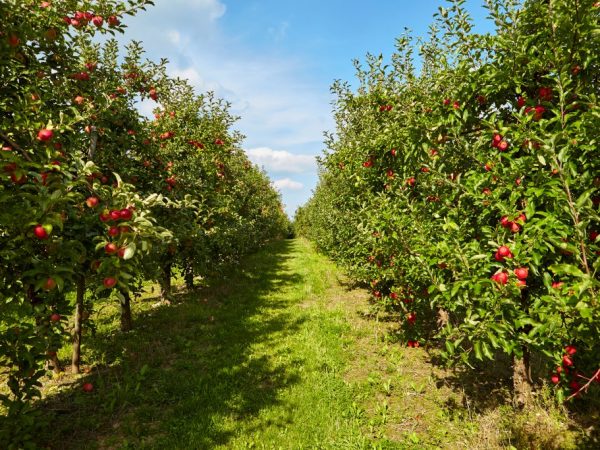
The variety is susceptible to various diseases
If pests or fungi have already appeared, trees are treated with insecticides and fungicides. When the problem is identified at an early stage, you can use folk remedies. For example, infusion of garlic, dill, tobacco, soapy water.
Some gardeners recommend planting marigolds, tansy, garlic, onions, wormwood, dill next to the apple tree. Their smell repels insects. In the fall, be sure to collect all the leaves and dig up the site. You can treat the ground with a solution of copper sulfate, insecticides or fungicides.
Preparing for winter
The Autumn striped variety does not require special preparation for winter: the apple tree tolerates even severe frosts, typical for Siberia.
It is advised to clean the garden well so that no leaves remain in it. A month before the expected frost, the tree is watered. A layer of compost is lined near the base of the trunk, which will serve as fertilizer in spring and warm the roots in winter.
Features of ripening and fruiting
Fruiting is higher. Only in rare cases for 4-5 years it is possible to collect several apples from a tree. Most often, the first harvest is obtained 7-8 years after planting.
Fruiting occurs a little earlier on a dwarf rootstock.
Yield by years:
- 10 years - 10-11 kg
- 15-20 years old - 150-200 kg
- 25-30 years old - 300-400 kg
In the best years, up to 8-10 tons of fruits can be obtained from 1 hectare.
In order to harvest a bountiful harvest for a long time, it is recommended to rejuvenate the tree from the age of 20. After that, it will be able to bear fruit for another 50 years.
If the variety is grafted onto a dwarf stock, you can get the first fruits as early as 3-5 years. But such apple trees live less, are more sensitive to frost.
Fruits begin to ripen in early or mid September, depending on the region. First, the apples turn yellow, then red stripes appear on their sides. They are more intense on the side facing the sun.
If the fruit ripens in the shade, only a few red lines may appear on the sides. When fully ripe, the stripes turn brown.
Harvesting and storage
Harvesting begins in early September. It is desirable that no hearths remain on the branches until the middle of the month. Falling off is rare, but late harvesting results in poorer storage.
You can only pick apples from branches manually. Carefully examine each fruit, put the damaged ones in separate boxes.
To keep the crop better, it is folded in one layer and covered with paper, grass, sawdust. Then transferred to a cool place.
Store at temperatures between 2⁰C and 5⁰C.From the beginning of December, they begin to sharply lose their juiciness, wither, become tasteless. By this time, the products need to be sold, processed or eaten.
At home, it is best to squeeze juices from apples or make jam.
Subspecies
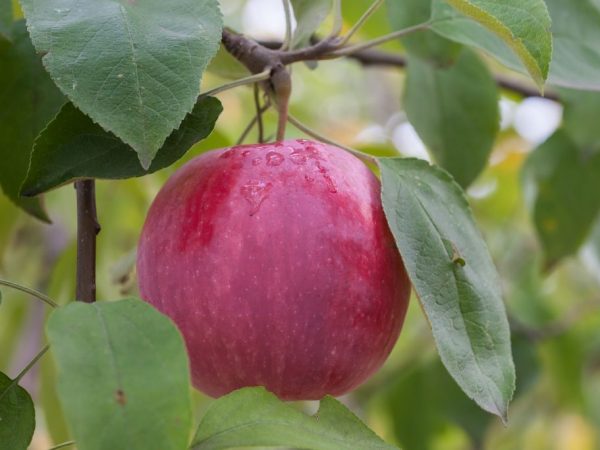
Subspecies differ in fruit color
There are several subspecies: they differ in the color of the peel, the height of the tree, the shape of the crown, the characteristics of maturation, and winter hardiness.
Yellow
According to the description, Streyfling yellow ripens late, by the beginning of October. The peel on the fruit is yellow, and turns almost orange in November. The stripes are red, wide, covering less than half of the apple. In the process of storage, they acquire a brown tint.
Red
By the time of ripening, the surface becomes completely red, the stripes are barely visible, and there is no yellow-green tint. The flesh immediately under the skin is pink, the rest is yellow. In terms of other properties, the red version is no different from the classic one.
Early
The early version is often called the Livonian one. Apples begin to ripen in the second half of August, and in the northern regions in early September.
The tree is tall, the crown is wide, the branches are partially hanging down. Fruits are stored for a short time, until the beginning or middle of November.
Rootstock options
On the dwarf
If you graft the Autumn striped variety on a dwarf rootstock, it will acquire some new qualities.
The height of the tree will rarely exceed 3 m, even without special pruning. You will only need to trim the side branches. The first crop is harvested for 4-5 years.
Winter hardiness in this case is lower, although some gardeners argue that this is not the case.
Columnar
The tree has a narrow crown, in which branches are directed upwards, parallel to the trunk, side shoots are not formed. The height reaches no more than 1.5-2 m. The branches begin to grow already at a level of 30 cm above the ground. The apples cover the entire stem evenly.
Begins to bear fruit early. Already for 7-8 years, up to 18-20 kg of the crop are harvested. The species will be winter-hardy, rarely damaged by insects and fungi.
Gardeners reviews
Apple-tree Autumn striped or Streyfling is a time-tested variety.
If you want your children and grandchildren to eat delicious fruits, plant such a tree in your garden and it will bear fruit for more than a decade. With just one apple tree, you can get 3-4 quintals of fruit.
This is one of the best options for the northern regions, it can withstand frosts down to -20-30⁰С. If some of the shoots or buds die in winter, they quickly resume. Recommended to be planted in the garden next to Antonovka. These species are excellent pollinators for each other.
Most gardeners note the juiciness of apples and a kilo-sweet taste with wine notes. They make excellent jams and marmalades. The juice is sweet, it can be preserved for the winter even without sugar.
The variety also has its disadvantages:
- Late start of fruiting and a slow increase in yield.
- Large size, requiring a large growing area, making it difficult to care for and collect the fruit.
- Unstable yields in aging apple trees.
- Dependence of taste and quality on the weather.
- Drought intolerance.
The variety is not very suitable for commercial breeding. Results can only be obtained in 10-15 years. And apples are stored a little, all products have to be sold when the cost of the fruit is low. Although processing companies are happy to buy them.

